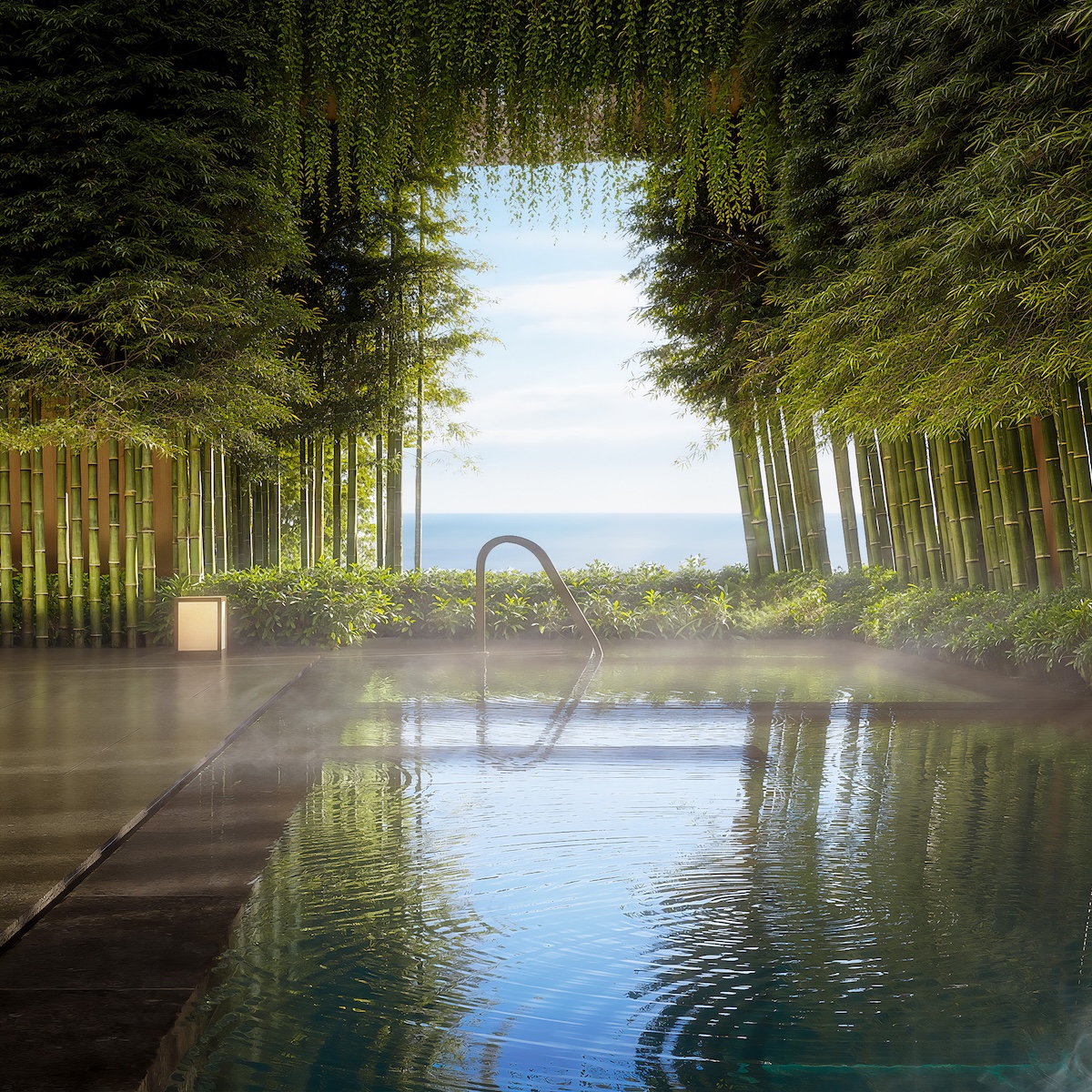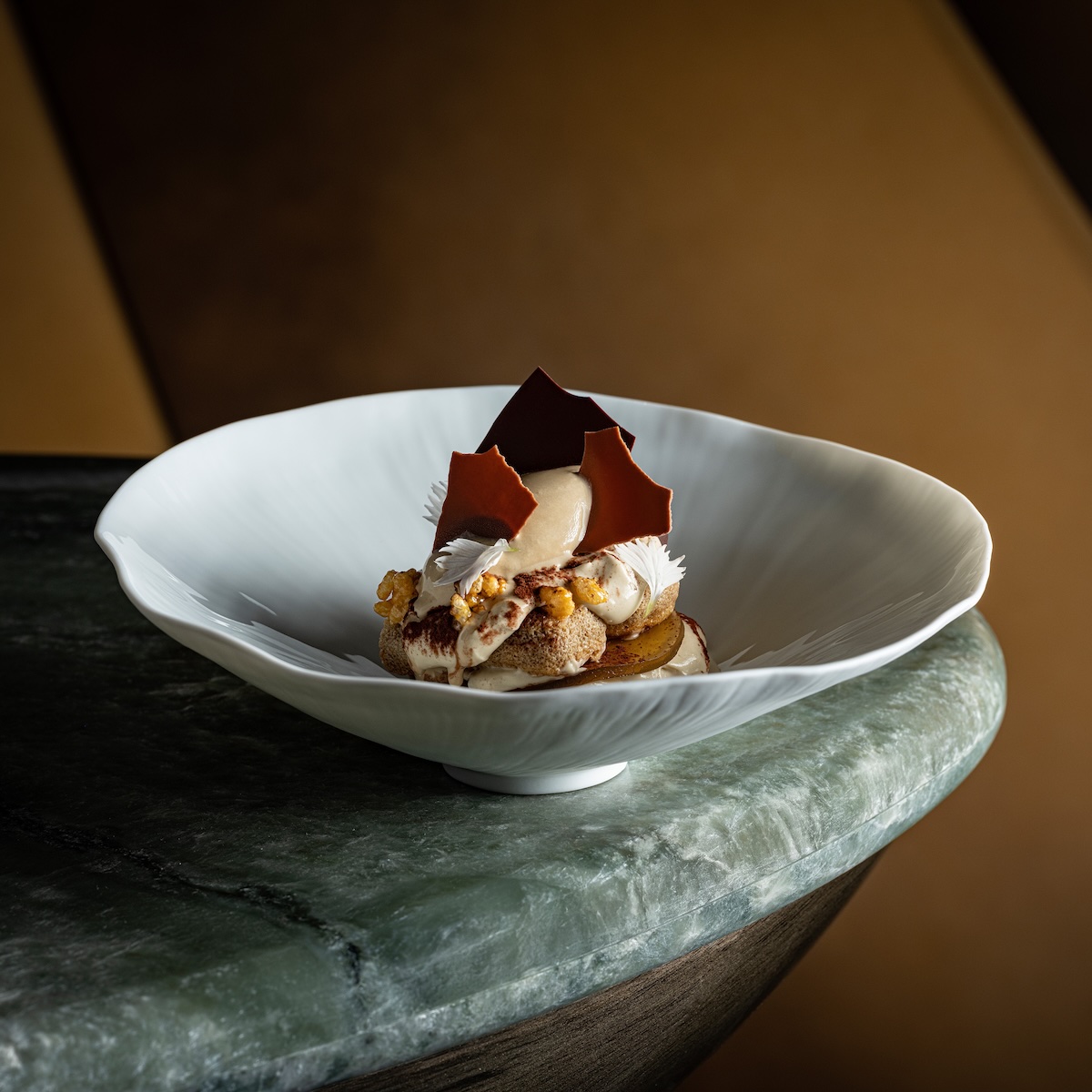By Jackie Chen and Jen Paolini
The Big Idea: The Travel Renaissance
Finally, travel is back.
In 2021, travel website Skift took a fresh, pandemic-era look at the hierarchy of luxury travel needs conceived by travel tech company Amadeus back in 2016. The pyramid’s bottom layer is the fundamental need for high service and product quality, but it’s the second level that saw a big change, with “authentic, vivid, all senses” experiences becoming a must in the time of sterile video calls and virtual tours.
One level above that, you’ll find experiences that provide indulgence and decadence or pampering and wellness, with the latter no doubt prompted by our increased awareness of health. In fact, a recent survey led by International Luxury Travel Market (ILTM) targeting luxury travellers in the Asia-Pacific region revealed that wellness has now become a key driver in our travel planning. In addition to using the spa and wellness facilities in a hotel or resort, some of us are willing to spend longer for more holistic, recuperative wellness journeys.
Next level up in the hierarchy is a need for privacy and few crowds, and at the pinnacle is health and safety. Of course, privacy has always been a consideration for luxury travellers, but the inclination towards less popular destinations is also understandable given concerns associated with crowding. This further plays into the appetite for niche and new destinations that come with unique or offbeat experiences as additional perks, and it echoes the ILTM survey, in which nearly half of the respondents said they’d opt for new venues and experiences in their next holiday plans.
It seems we wanderlusters just can’t wait to embrace the bigger world outside. And unsurprisingly, the relative confinement of the past three years has led luxury travellers to consider longer, larger travel plans too, with around half looking to take holidays that last longer than a week, while a significant number are planning to travel more to make up for lost time and to take more extravagant holidays than before. These prolonged sojourns, we hope, will allow us to cultivate more in-depth connections with locals and their culture, making for a more meaningful experience.
All that said, it seems we’re all still fans of city staycations, once a mere pain reliever. After all, even a short stay near home is good for breaking routine and exploring what our local venues have to offer. According to the ILTM survey, that’s not changing soon.
But whatever your specific plans, it seems we can finally say: good to see you again, travel. We should definitely do this more often.
Zadún, a Ritz-Carlton Reserve
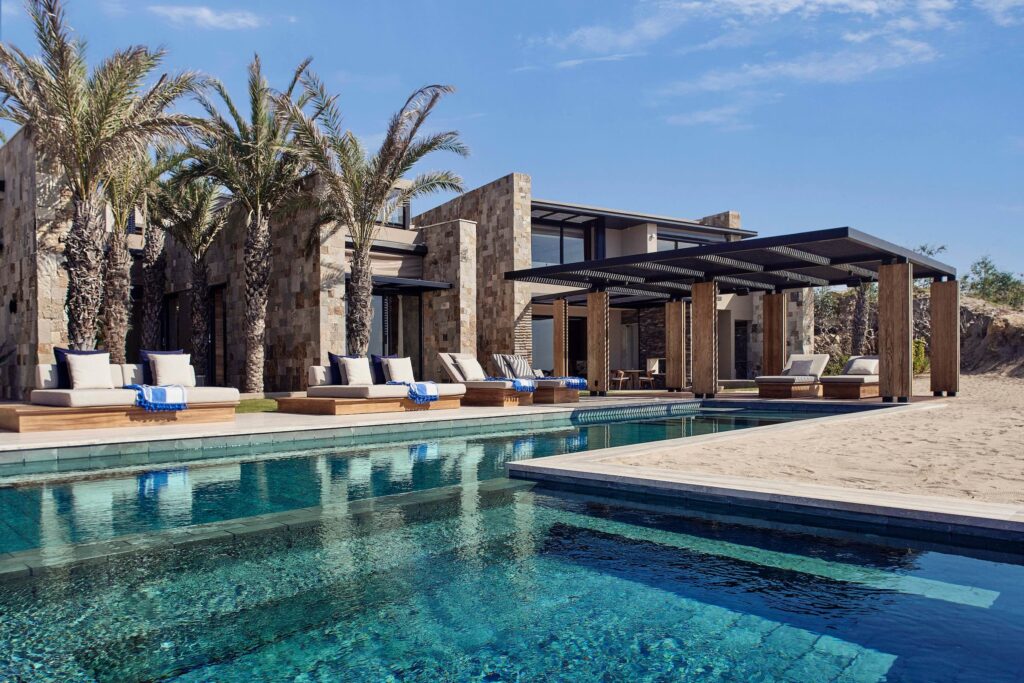
One of only five Ritz-Carlton Reserve resorts globally, Zadún’s location on the southern tip of Mexico’s Baja California peninsula gives it a unique environment where ocean meets desert. Taking advantage of the topography, the 113-key resort’s 42 two-storey villas are perched along the gently sloping dunes overlooking the Sea of Cortez. The ultimate luxury here is embodied in the 550-square-metre Grand Reserve Villa, which boasts five bedrooms, multiple lounge spaces, a pool, and its own gym.
The hotel’s impressive 2,700-square-metre Spa Alkemia is the place for the region’s most innovative wellness experience, with a plethora of rejuvenating treatments such as sound therapy; the unique Templo de Calor, a modern interpretation of the traditional Mexican temazcal healing hut; and the outdoor renewal garden Alkemia al Fresco, which features seasonal, hand-selected body scrubs.
Outside your leisure time, you can also engage in the resort’s Ambassadors of the Environment programme created by Jean-Michel Cousteau’s Ocean Futures Society. From hiking to stargazing to discovering the history of chocolate, guided excursions and workshops led by the programme’s naturalists offer a unique opportunity to explore the area’s abundant flora and fauna, as well as its rich cultural heritage.
Image courtesy of Zadún, a Ritz-Carlton Reserve.
The St Regis Hong Kong

When it comes to St Regis, what pops into your mind probably includes its signature butler service, champagne sabring ritual, grand spiral staircase, and the can’t-miss Bloody Mary that comes in a rendition local to every property. But at The St Regis Hong Kong, there’s more than that.
Opened in 2019, the hotel is centrally located in Wan Chai, and offers all the conveniences you’d expect. Dining options are well curated, from fine French fare at L’Envol to Michelin-starred Chinese at Rùn, as well the casual Drawing Room and of course a St Regis bar. But it’s most widely celebrated for its design, for which renowned designer André Fu drew on both elements of The St Regis New York and his childhood memories of Hong Kong.
Touches of local heritage are everywhere. Enter the intimate lobby beyond the capacious porte-cochère, then make your way to the Great Room on the second level, and you’ll see opulent lanterns and sconces that evoke the 19th-century gas lamps of old Hong Kong, bronze screens reminiscent of colonial-era window mullions, and artisanal lacquer work that recalls fine Chinese craft. The Great Room’s massive chandelier is a tribute to the city’s famed skyline. And in the bar, a hand-painted mural depicts the city’s historic features, rich vegetation and natural foliage, and colourful street scenes set against old buildings. Local elements are further extended to the hotel’s 129 accommodations, though never as pastiche; rather, Fu has created a space that carries the brand’s DNA while functioning as an ode to Hong Kong’s distinctive architecture and culture.
Image courtesy of The St Regis Hong Kong.
Buahan, a Banyan Tree Escape
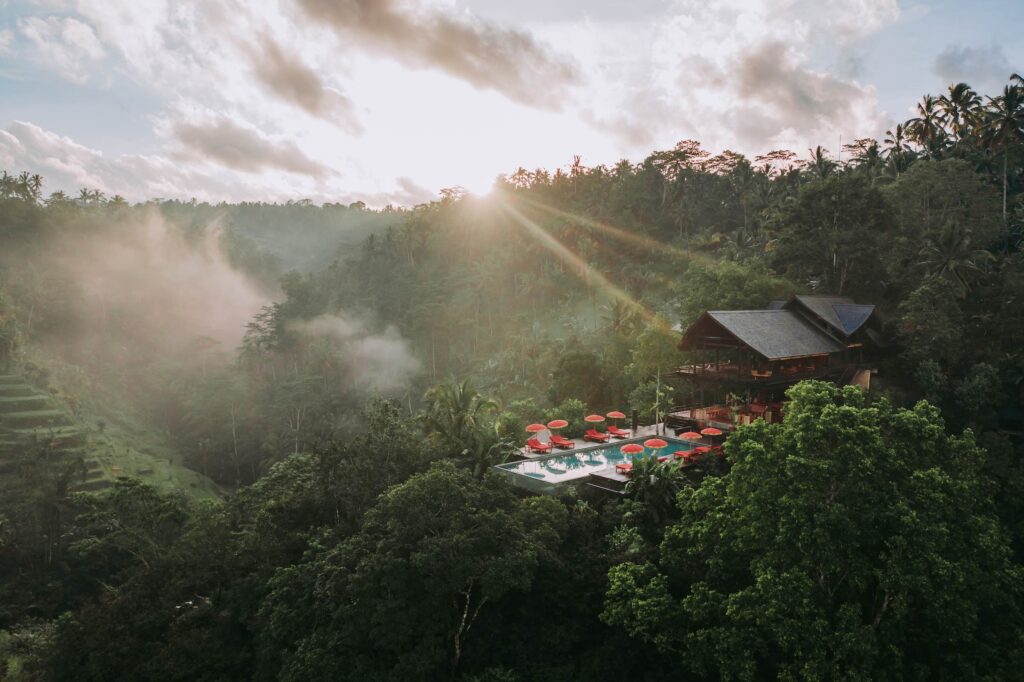
Tropical paradise Bali has no shortage of sandy beaches, turquoise waters, lush jungles, and decadent resorts. But this new Banyan Tree takes the whole communing with nature thing one step further with its “naked” setting.
What’s naked? Well, the quiet, adults-only enclave in an off-the-beaten-track, untouched part of northern Ubud boasts 16 balés (villas) that come without walls or doors. Forget the traditional, air-conditioned hotel rooms: the resort promises a borderless connection to nature. Expect an otherworldly experience with 180-degree panoramic views over the lush Balinese jungles, rice paddies, and mountain peaks, a wake-up amid the mist at dawn, or a soothing bath in the open-air bathtub with fireflies visiting your villa at night.
Fortunately, the lack of AC doesn’t impinge on the comfort factor. The resort’s altitude of 600 metres above sea level means the average temperature remains around 23 degrees Celsius during the day, with natural breezes and fans around the sleeping area keeping things cool. And there’s no need to worry about prying eyes, either, as each villa stands at a distance from the next and is nestled into the steep topography and dense greenery.
Image courtesy of Buahan, a Banyan Tree Escape.
K11 Artus
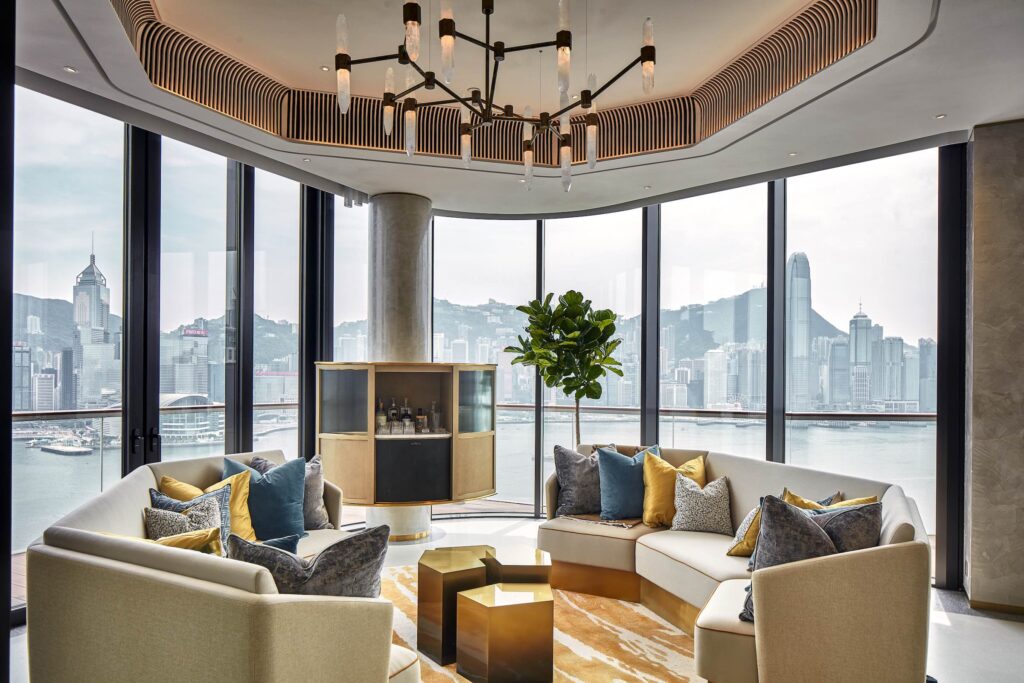
Indispensables for a good long-stay experience: a prime location that allows you to explore the city and get around conveniently, a fully equipped space, dining and wellness facilities that take care of your body and soul, and personalised assistance. These are what K11 Artus endeavours to provide its guests.
The experience is elevated, with large, well-appointed suites that come with kitchens, closet space, and a dedicated storeroom for luggage, as well as thoughtful amenities and balconies with panoramic harbour views. This is further complemented by the residence’s digital concierge desk Amici, which is easily accessible via common communications apps, and an IPTV feature that allows you to order food directly from the adjacent K11 Musea mall, whose event and facility information is also displayed on a real-time basis.
So far, so luxury serviced residence. But K11 aims to be Asia’s first hybrid “artisanal home”, with an inspiring environment that delights the creative spirit and whose creation has been led by renowned designers. From the interior design to the landscaping to the objets d’art that bedeck the interior space, it’s sure to give you a bit of added inspiration.
Image courtesy of K11 Artus.
Shangri-La Shougang Park, Beijing
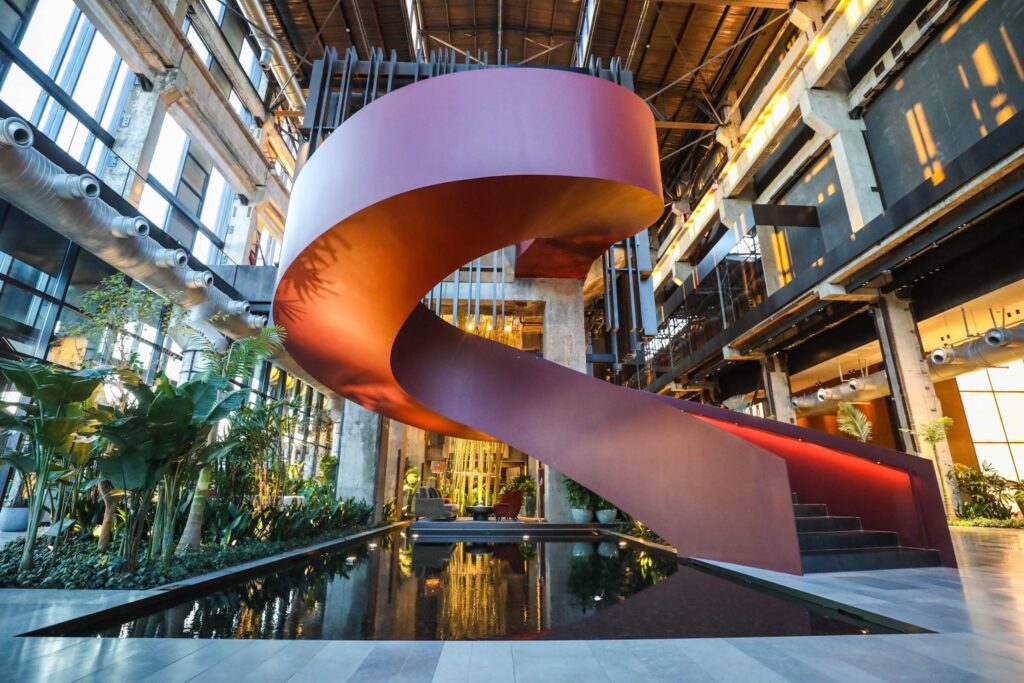
Fans of industrial-inspired design will want to check out the new Shangri-La in erstwhile industrial area Shougang Park, now revitalised as a creative landmark. Building on the original architectural foundation of the former Shougang Power Plant, the new hotel is a fine exemplar of adaptive reuse from industrial to vibrant urban living space.
The complex consists of three buildings. The first maintains the original framework of the power plant, enclosed by an extensive glass façade to leave its structure intact while controlling the light and temperature inside. The second houses the hotel’s event and leisure facilities, while the third is home to the 283 rooms and suites affording views of Shijingshan Hill, Yongding River, and Qunming Lake.
Led by renowned Italian designer Piero Lissoni, the design aims to reflect Shangri-La’s design pillars of Asian Sensibilities, Nature Inspired, and Spirit of Place. This begins in the lobby, where an emblematic red steel spiral staircase connects different public spaces. Evergreen plants transform the space into an indoor garden, and large windows invite the outdoor greenery inside, with contrasting steel elements recalling its industrial heritage. Rooms are Asian-inspired and minimalist, privileging the view through full-height windows and giving you that feeling of being amongst it all.
Image courtesy of Shangri-La Shougang Park, Beijing.
Capella Bangkok
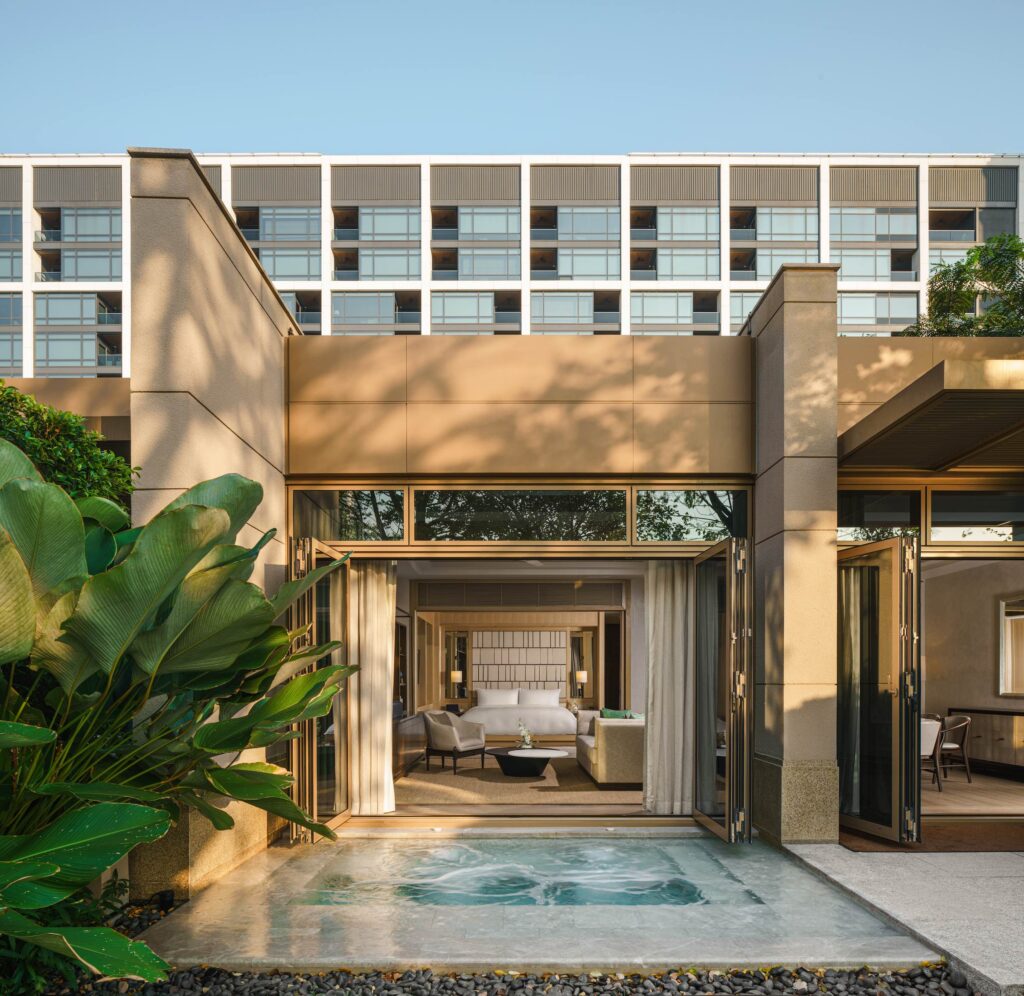
Sometimes you don’t need to fly to the end of the world to escape from city life: urban resorts are a growing typology, one that allows you to cast the daily hustle and bustle aside and get into holiday mode while offering the convenience of a city. One fine example is Capella Bangkok, a resort perched on the banks of the Thai capital’s iconic Chao Phraya River.
On stepping inside, the hubbub disappears into the resort’s abundant greenery and expansive interior space. There are uninterrupted river views from all the 101 river-facing accommodation types, including seven riverside villas—the first of their kind in the city. Amid them is the Presidential Villa, a grand private residence that spans a stunning 595 square metres and is accessed via its own entrance. Here, the famed river forms part of the villa’s backyard together with a lush tropical garden, an outdoor Jacuzzi plunge pool (standard on all villas), a secluded sala, and a waterfront dining space that’s just asking for a romantic al fresco dinner.
Complementing this riverside tranquillity are jet lag wellness treatments on arrival and a daily apero service exclusive to villa residents. And of course, there’s more to indulge in, such as Michelin-starred Côte helmed by three-star chef Mauro Colagreco, the award-winning Auriga spa, and bespoke experiences curated by your dedicated Capella Culturist.
Image courtesy of Capella Bangkok.
Rosewood London
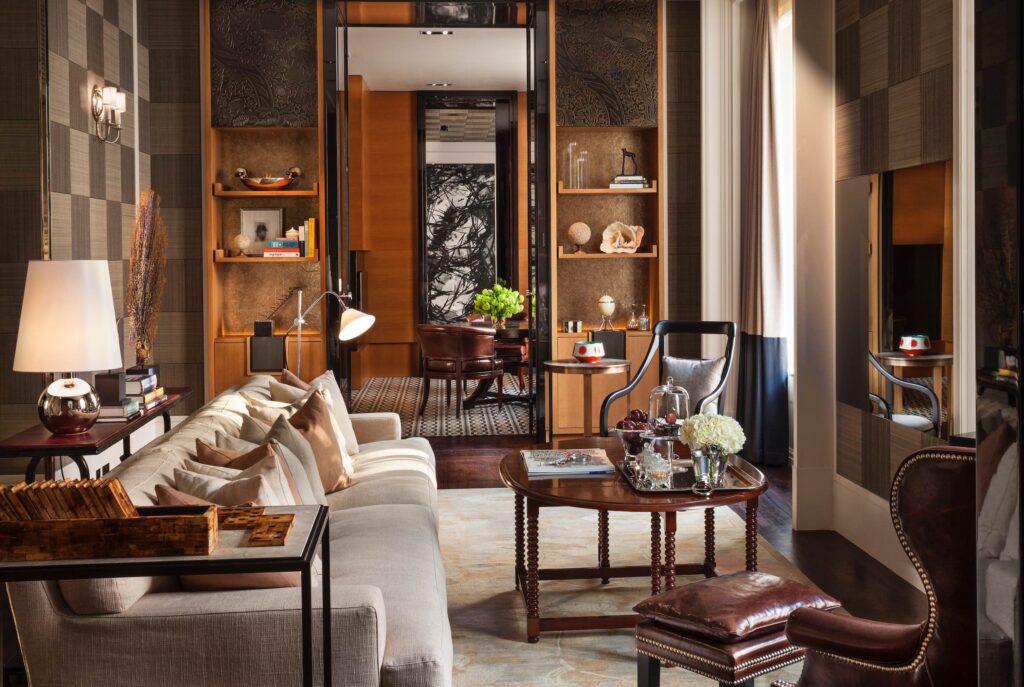
Housed in a renovated Grade II-listed Belle Époque building, Rosewood London feels like a mansion in the city. Accessible via a grand carriageway that leads to a distinctive courtyard, the stylish residence is really more akin to a manor house.
Multiple restaurants designed by the likes of Tony Chi and Martin Brudnizki serve contemporary cuisine with a focus on British, plus there’s the cheeky Scarfes Bar for cocktails and Rosewood’s Sense spa for some self-care.
While there are 263 rooms, suites are the focus here, the nine Signature Suites being the stars. Three of these—Manor House, Lincoln House, and Garden House—can be booked individually or with additional adjacent bedrooms or suites and transformed into a wing.
The piece de resistance is one of these, and the only suite in the world that has its own postcode: the 585-square-metre Manor House Wing. The expansive space includes multiple lounge and living spaces, a dining room, a library, and up to seven bedrooms, among which the master is fitted with a large dressing room and a Carrara marble soaking tub. Or maybe the Garden House is more your thing: the penthouse features a private garden terrace with an outlook to the London skyline.
Image courtesy of Rosewood London.
Cheval Blanc Paris
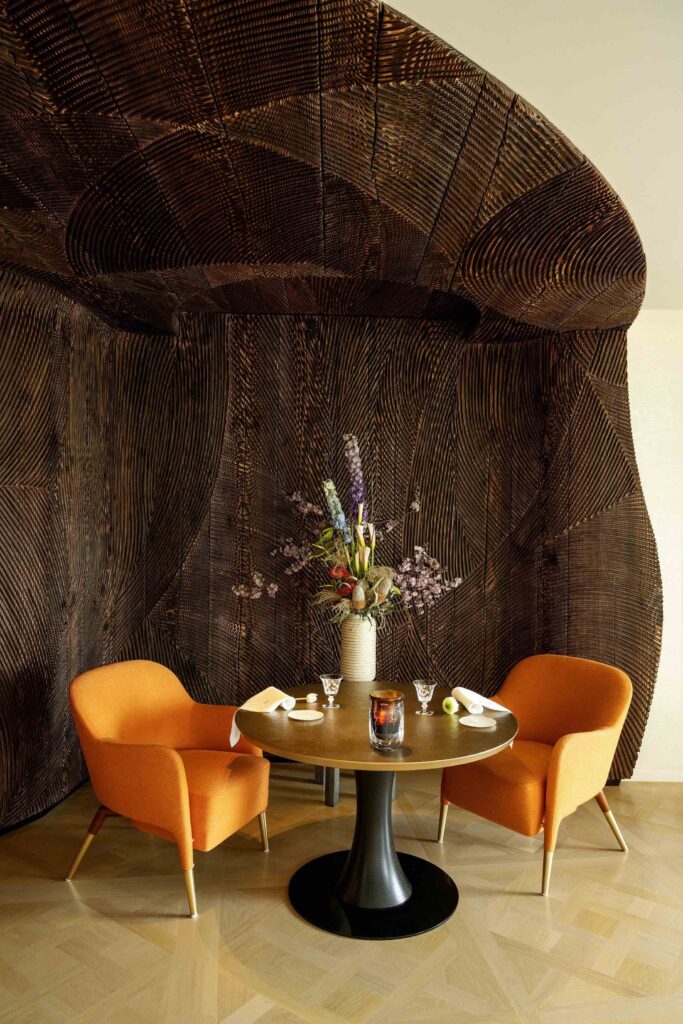
Housed in the same complex as the historic Art Deco and Art Nouveau masterpiece La Samaritaine, on the Seine and just a stone’s throw from the Louvre, Cheval Blanc Paris is the fifth hotel and the first urban iteration in LVMH’s Cheval Blanc collection. This is a pure LVMH maison where you can indulge in a fully immersive LVMH experience within and the best of Paris outside.
It’s an impressive place, to be sure. The interiors, including 26 rooms, 46 suites, and four restaurants, have been realised by Peter Marino in the style of a Parisian residence; working to this brief, skilled artists and craftspeople have helped to realise the hotel’s distinctly French approach to the art de vivre. Rooms overlook the Seine at the Pont Neuf, its oldest bridge. Restaurants are overseen by chef Arnaud Donckele and pastry chef Maxime Frédéric, and pay homage to the best of French and Italian cuisine.
You can also get pampered at the Dior Spa, where new technologies meet exclusive Dior manual techniques. The six treatment suites all come with private white onyx bathrooms, and a number of exclusive products celebrating the union between Dior and Cheval Blanc are available. Or drop by the Rossano Ferretti Salon for the artist’s famed invisible cut.
Moreover, just steps away, following a multi-year renovation by LMVH, the historic La Samaritaine itself has reopened in its full Belle Époque glory with a roster of high fashion, horology, jewellery, and gourmet treats.
Image courtesy of Cheval Blanc Paris.
Park Hyatt Niseko Hanazono
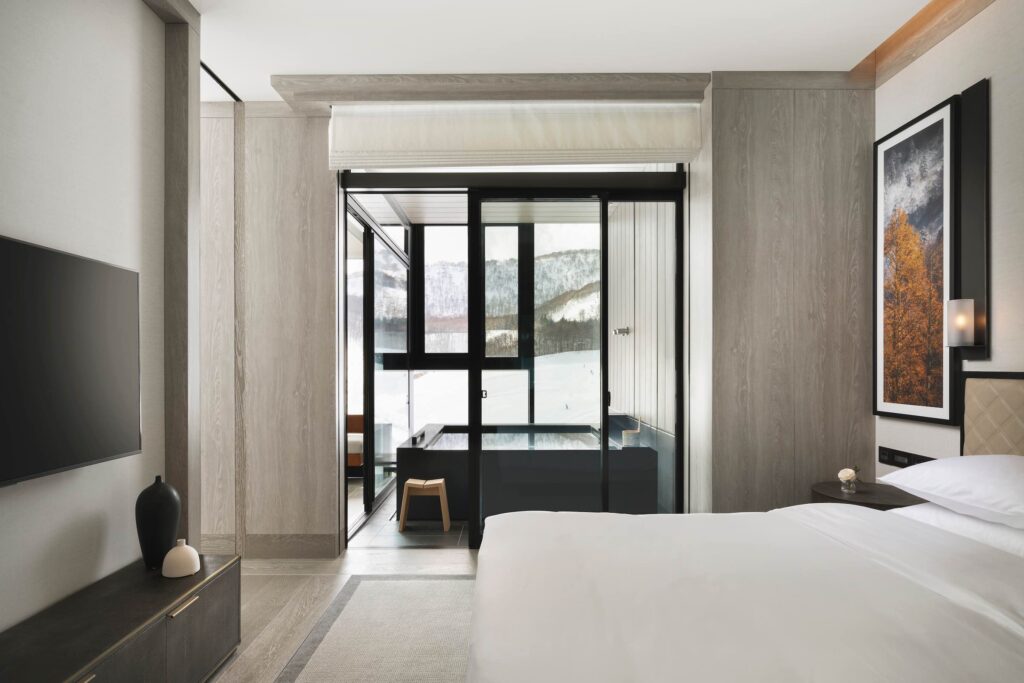
It’s natural for people living in tropical areas to flock northward in pursuit of snow in winter, and not too far away from Hong Kong lies Niseko, a destination that’s rapidly become a darling of ski bunnies for its fine powder.
Nestled in Hanazono on the northeastern side of Mount Annupuri, Park Hyatt Niseko Hanazono takes advantage of the destination’s exceptional powder and world-class skiing and snowboarding facilities, providing ski-in, ski-out convenience, night skiing, guided snow shoeing, and courses from beginner to expert. The 60 Residences range from studios to three-bedroom versions, and perched on the resort’s top floor, the most luxurious and exclusive Annupuri Suite and Yotei Suite each come with a terrace and veranda, while affording dramatic views of Mount Yotei that can be enjoyed from an oversized private onsen.
In fact, each of the 60 residences and nine of the 28 suites come with a private onsen that’s perfect for relaxing after a ski, but if you’re after something more active there’s an abundance of après-ski entertainment options. Multiple restaurants encompass French, Italian, Chinese, and of course Japanese, from sushi to robata, and there are multiple bars including private options, as well as private wine tasting cellars.
As a year-round destination, the resort also offers summer fun from golf to mountain trekking, river rafting, and more. But for us, it’s all about that sweet powder.
Image courtesy of Park Hyatt Niseko Hanazono.
Amankora
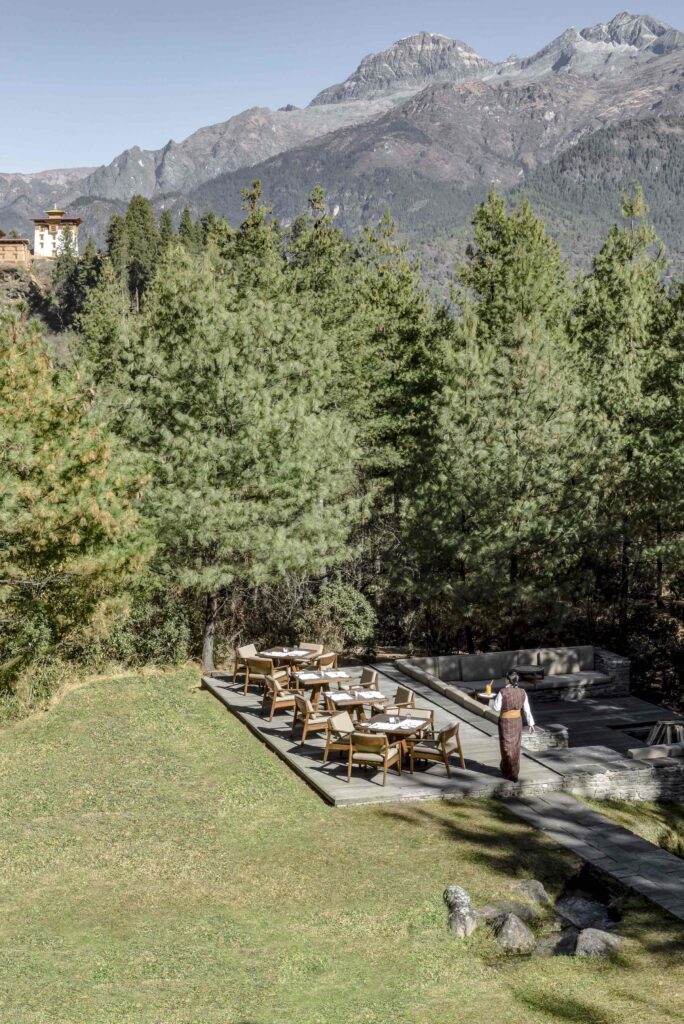
Aman’s collection of rustic-chic hotels in the “Kingdom of Happiness” has long served travellers as a soothing environment to ease themselves into this otherworldly and mystical nation. In its almost 20 years of presence in the Land of the Thunder Dragon, Amankora’s mindful service, impeccable design, and unparalleled access to the cultural heart of Bhutan have been at the centre of its unique brand of hospitality, and its almost reverential approach to wellness feels completely at home in the spiritual peaks of the snowy Himalayas.
Ranging in size from an intimate eight-suite getaway to a sprawling 24-key lodge, the same contemporary-meets-natural design motif is infused throughout all properties. Sleek, minimalist rooms boast spacious open plans, connecting bedrooms with living rooms and en-suite bathrooms. Freestanding bathtubs, cushioned window seats, and traditional bukhari wood stoves are just a few of the features found in each room.
Despite the connective thread in the design, each of the five lodges carves out its own niche: Thimphu, for example, is modelled in the style of a classic dzong fortress; Punakha was revitalised from a traditional farmhouse belonging to a former chief abbot of the country; and Gangtey sits on a knoll within a wildlife reserve, overlooking a 16th-century monastery.
Nature plays an influential part in Amankora’s identity, evident through its strategic locations and surrounding landscapes of rice terraces, dense pine forests, wild rivers, and deep valleys. It also happens to be the perfect launchpad for trekking the newly restored Trans-Bhutan Trail, an ancient pilgrimage path that spans the country. Activities and healing experiences are abundant and differ between locations, with signature Aman-style spa treatments, hot stone baths, yoga rooms, pools, and cultural experiences on offer, while the dining programme spans Bhutanese, Indian, and Western cuisines.
Image courtesy of Amankora.
The Peninsula Hong Kong

The “Grande Dame of the Far East” celebrates its 95th anniversary this year. The city’s most historic hotel boasts 300 elegantly appointed accommodations, eight distinctive restaurants and lounges, and a spa that spans more than 1,100 square metres.
The hotel has been a trailblazer in luxury since its opening in the early 20th century. When it opened its doors in 1928, it was the first hotel in Asia to introduce pages, a cadre of uniformed helpers on standby to provide personal services—and you can still see them in the hotel today. In 1970, it placed the world’s largest order for Rolls-Royces to chauffeur guests in style. Nowadays, the fleet is made up of 14 Phantoms and one 1934 Phantom II, with two additional Mini Cooper S Clubmans available for airport transfer or private hire. And the 30-storey extension that opened in 1994 saw the introduction of two private rooftop helipads, making airport transfers a breeze and sightseeing a thing of beauty.
Here, traditions are well conserved and inherited. The pages are outfitted much as they were in 1928, and much of the silverware made by Roberts & Belk in the UK for the hotel’s opening is still in use. Visiting is like stepping into a space where time doesn’t seem to pass, and legacy endures.
Image courtesy of The Peninsula Hong Kong.
Regent Phu Quoc
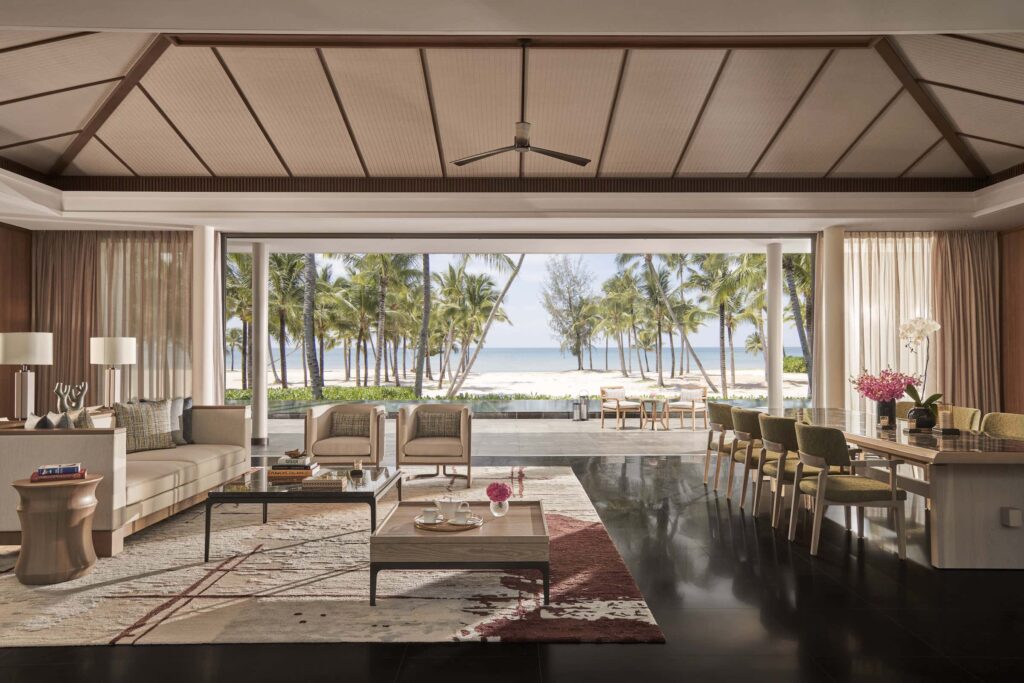
Southeast Asia’s long-awaited first Regent resort has landed on the emerging island destination Phu Quoc in southern Vietnam. Located along Long Beach, which forms part of the island’s southwestern coastline, the all-new Regent Phu Quoc lives up to all our expectations of a luxury beachfront resort.
In this all-suites-and-villas resort, Regent’s distinctive new hallmarks are here to be experienced to the fullest. The Personal Havens experience, for example, is a bespoke stay with abundant individual choices from wellness to menus, scents, and literature. The Taste Studio takes your culinary whims and makes them happen at a special location of your choosing.
Dining within the resort won’t disappoint either, with six restaurants and bars covering a range of options from Japanese-French fusion at Oku (the only omakase on the island) to Vietnamese, Chinese, and some tasteful options for a libation from beachfront to sky terrace.
Within and outside the resort, there are plenty of other experiences on offer, from the in-house gallery to island explorations, catamaran trips, or anything else you and your dedicated Experience Agent can imagine.
Image courtesy of Regent Phu Quoc.
Vox Pop: The Way Ahead
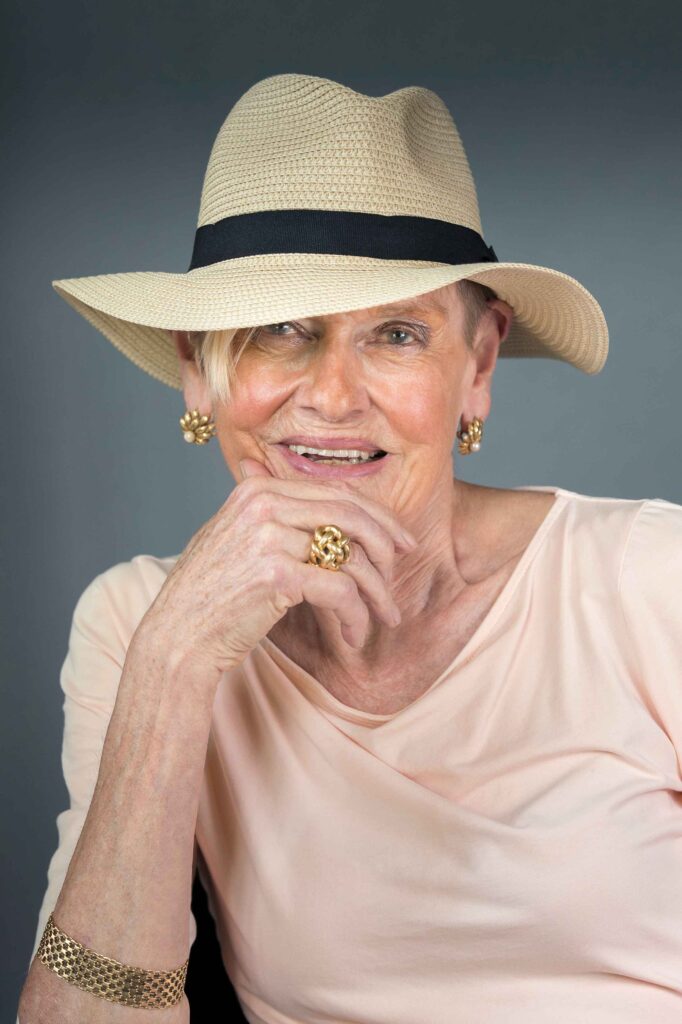
As I write this on my way to Cannes for ILTM, the world is changing again and the world of travel along with it. As borders have opened up, the big craze for staycations, those weekends in top suites in your hometown, have quickly become less significant. Obviously, this has impacted hotels: in Hong Kong, for instance, such treasures as the Mandarin Oriental, the Ritz-Carlton, and their peers are having to market elsewhere, first close to home but gradually further afield.
Likewise, we travellers are having to adjust in ways large and small. No longer can we throw our full-sized toiletries in our favourite Dior holdall and head straight to dinner in our staycation home—we’re back to thoughtful packing, with miniature toiletries ready for security checks at the airport and mental preparation for all the extra time that involves.
Looking ahead to 2023 and beyond, I expect growth in private aviation, sometimes offered by the hotel in question (Joali in The Maldives is a case in point). We’ll still travel in twos, but more and more we’ll see solo travellers. And at the other end of the spectrum, bigger and bigger private groups, be they polo pals or extended family gatherings.
I expect even more emphasis on experiences in determining destination choices. From art events to marathons, reasons stimulate travel buying. Wellness is becoming noticeably mainstream, as is sustainability. But the latter at least has been around in travel for long enough that many take it for granted. It serves as just another example, if one were needed after the past three years, of how well we can normalise behaviour, and how adaptable our industry has become.
By Mary Gostelow, luxury travel authority






